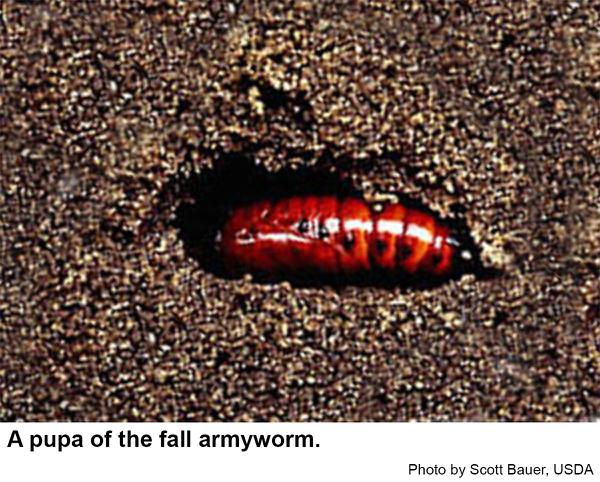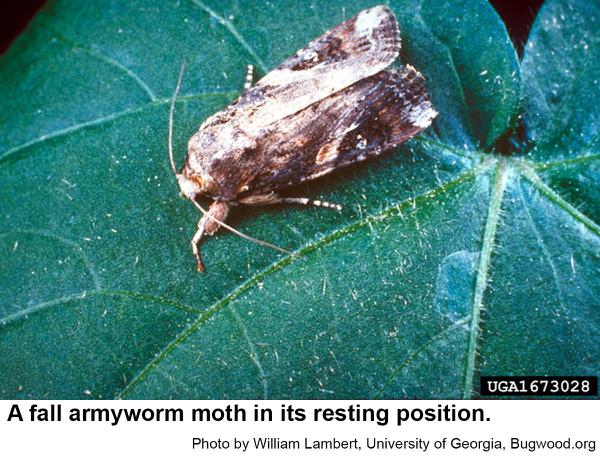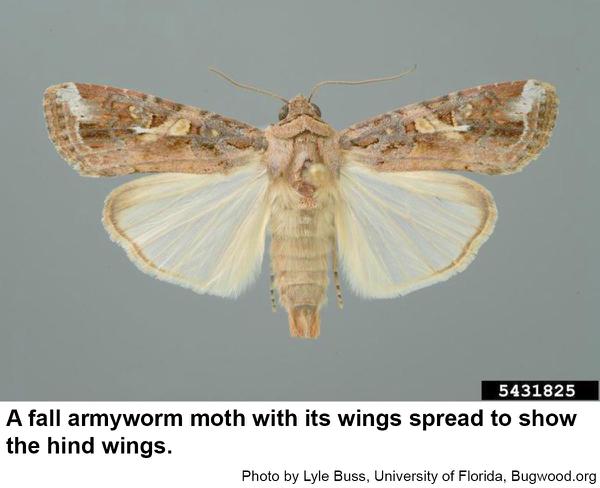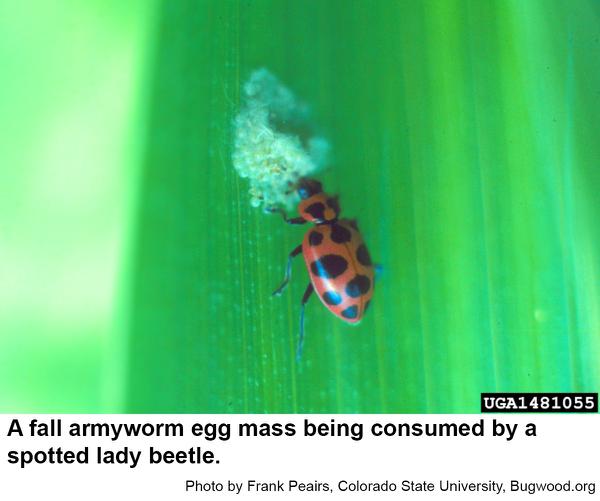Description and Biology
Moths of the fall armyworm, Spodoptera frugiperda, invade North Carolina each year from the Gulf Coast states where they overwinter as pupae. The moths usually arrive in mid July and their caterpillars become more and more abundant as the weeks go by, hence the name fall armyworm. Each moth can lay as many as 1,000 eggs on flowers, turfgrasses, and other crops. The moth has a wingspan of about 1½ inches. The hind wings are white with buff edges; the front wings are dark gray and mottled with lighter and darker splotches. Each forewing has a noticeable whitish spot near the extreme tip. Fall armyworm eggs are minute, light gray and are laid in clusters covered with grayish, fuzzy scales from the body of the moth. The eggs become very dark just before hatching. This green, brown, or almost black caterpillar and resembles the corn earworm in shape and markings. However, the fall armyworm has a distinct, pale, inverted “Y” on the front of its head. Each side of its body has a black stripe and each abdominal segment has four black dots on top. After feeding for 2 to 3 weeks, armyworms dig about an inch into the ground to pupate. The pupa is reddish-brown and darkens to almost black as it matures. Within 2 weeks, a new generation of moths emerges and may fly several miles before laying eggs. Dry weather in late summer may cause this insect to move from field crops and pastures to landscaped areas. Several generations occur each year in North Carolina.
Host Plants
The fall armyworm has a wide host range but prefers grasses. Fall armyworms may migrate in large “armies” and invade landscapes consuming all above-ground parts of herbaceous ornamentals. They seem to prefer feeding on the flowers of African violet, chrysanthemums, and other ornamentals. They tend to feed on the foliage of ornamental grasses.
Residential Recommendations
Because these caterpillars have an enormous host range including weeds that are never sprayed, fall armyworms are not likely to have developed resistance to insecticides. Unfortunately, fall armyworms tend to infest the flowers of ornamental plants, which presents a dilemma: applying an insecticide to flowers may harm bees, butterflies, and other pollinators. Fortunately, fall armyworms are not a really common pest of flowers so hand picking or dislodging and trampling underfoot may provide sufficient control. Foliage may be sprayed those insecticides labeled for landscape use to protect the foliage of plants from fall armyworms.
References
- Common name: fall armyworm, scientific name: Spodoptera frugiperda (J.E. Smith) (Insecta: Lepidoptera: Noctuidae). John L. Capinera, J. L. 2017 (revised). Entomology & Nematology, FDACS/DPI, EDIS Publication Number: EENY-98.
- Insect and Related Pests of Flowers and Foliage Plants. Baker, J. R. ed. 1994 (revised). North Carolina Cooperative Extension Service publication AG-136.
- Review of Fall Armyworm (Lepidoptera: Noctuidae) Genetic Complexity and Migration. Nagoshi, R. N. and R.L. Meagher. 2008. Florida Entomologist, 91(4):546-554.
- Extension Plant Pathology Publications and Factsheets
- Horticultural Science Publications
- North Carolina Agricultural Chemicals Manual
For assistance with a specific problem, contact your local Cooperative Extension Center.
This Factsheet has not been peer reviewed.
Publication date: Feb. 13, 2017
Reviewed/Revised: Sept. 16, 2019
Recommendations for the use of agricultural chemicals are included in this publication as a convenience to the reader. The use of brand names and any mention or listing of commercial products or services in this publication does not imply endorsement by NC State University or N.C. A&T State University nor discrimination against similar products or services not mentioned. Individuals who use agricultural chemicals are responsible for ensuring that the intended use complies with current regulations and conforms to the product label. Be sure to obtain current information about usage regulations and examine a current product label before applying any chemical. For assistance, contact your local N.C. Cooperative Extension county center.
N.C. Cooperative Extension prohibits discrimination and harassment regardless of age, color, disability, family and marital status, gender identity, national origin, political beliefs, race, religion, sex (including pregnancy), sexual orientation and veteran status.





